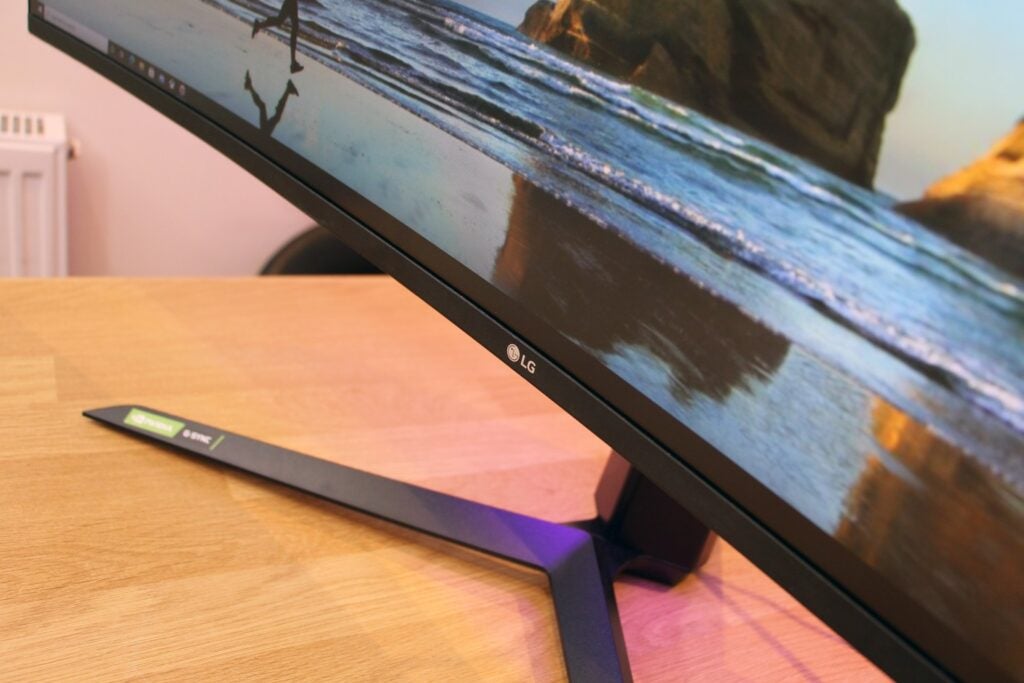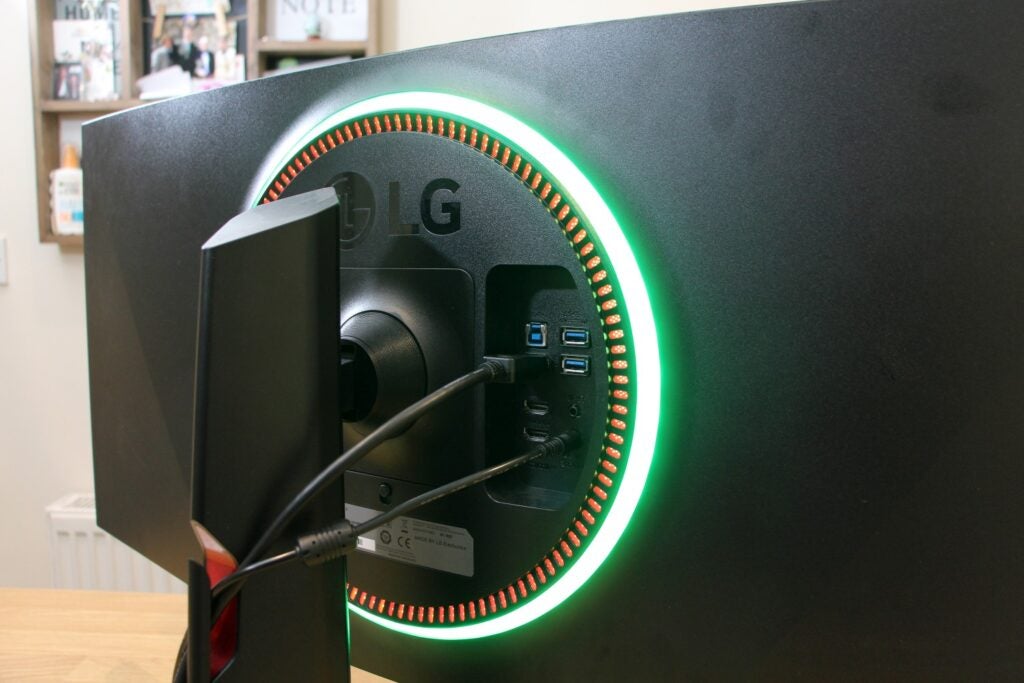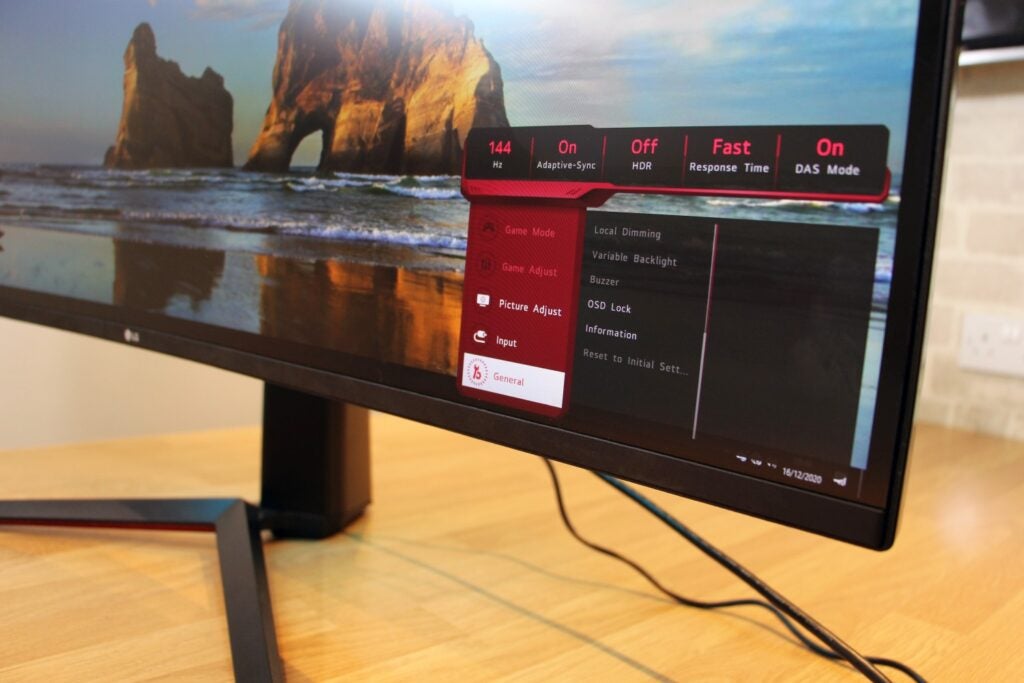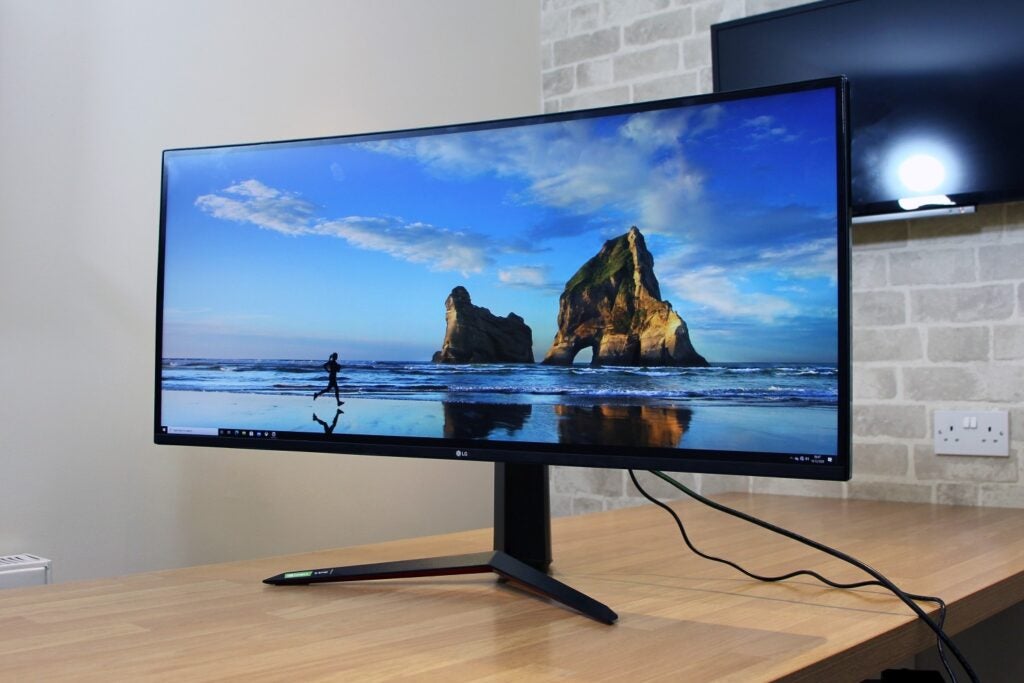LG UltraGear 38GN950 Review
A curvy gaming monitor with a very high price


Verdict
The LG UltraGear 38GN950 is one of the most expensive gaming displays around: it will set you back £1499 in the UK and $1499 in the US.
It’s a significant sum of money, but the LG does have the sort of specification to justify the cost – at least on paper.
It’s a 38-inch panel with a 21:9 aspect ratio, and this super-wide display is paired with a resolution of 3840 x 1600. There are high-end specifications elsewhere, too, including a ring of 48 RGB LEDs for illuminating your gaming den.
LG UltraGear 38GN950 design and features – Curvy and flashy
The LG’s size, aspect ratio and resolution deliver an impressive gaming experience. The size means I can get an immersive view without the panel proving overwhelming, and the extra width results in greater room for horizontal action in games, which is especially important in racing titles or shooters.
This widescreen is curved, with a gentle radius of 2300R. That’s modest, with most curved panels sitting at 1800R and rivals such as the Samsung Odyssey G9 making the curve tighter at 1000R.
The two displays take wildly different approaches to curved panels. The LG’s subtle curve can help with viewing angles and is a great option if you find the tighter designs elsewhere overly oppressive. However, the wider G9 and its tighter radius can potentially deliver a more immersive wraparound experience.

The LG UltraGear 38GN950 comes with AMD FreeSync that runs at 144Hz with a 160Hz overclock option – and it’s the Premium Pro version, which means added support for HDR and low frame-rate compensation. The LG is compatible with Nvidia G-Sync, too. Samsung went further by offering a 240Hz refresh rate, but the 144Hz rate here is still ample for mainstream gaming and competitive play.
This panel is an IPS display, which instantly marks this screen out from the VA-based Samsung. The UltraGear has a tremendous 1ms response time, and it also uses 10-bit colour – two attributes that it shares with the G9.
The LG doesn’t support Display Stream Compression over DisplayPort, so if you want 10-bit colour then you can’t run the refresh rate beyond 120Hz. This is a minor issue, given how few games support 10-bit colour. Don’t expect much from the HDR on this display, either; the LG only adheres to the mid-range DisplayHDR 600 protocol and it has an underwhelming 12 dimming zones.
Related: Best gaming monitor

I’m a big fan of the slim bezels and narrow legs – it certainly looks like a gaming display. It offers 110mm of height adjustment, and VESA mount support, but no tilting.
The monitor weighs only 9kg, which is impressive – but the body’s build quality is underwhelming. I found the plastic to be a bit weak, and the display wobbles too much. It isn’t a big issue when the LG is in position, but Samsung’s display proved sturdier and offered more adjustment options.
One of the LG’s most exciting features can be found at the rear. A ring of RGB LEDs sit around the stand, illuminating the wall behind the display. They’re bold and bright, and LG’s Control Center software can be used to switch between modes: the lighting can be static, can switch between different colours, or synchronised with your music or gameplay.

I can adjust the rest of the LG’s settings with a conventional on-screen display and a snappy joystick. I found the OSD to be fast and easy to navigate, although making the menu bigger and the font smaller would have been welcome, allowing LG to cram more options onto each screen.
Finally, at the rear, you’ll find two HDMI inputs: one DisplayPort connection and two USB 3.2 Gen 1 ports. They all face outwards, so offering easy access, but there’s no USB-C or Thunderbolt.
Related: Best PC Games 2020
LG UltraGear 38GN950 image quality – Top-notch visuals, but lacking HDR options
The LG’s resolution of 3840 x 1600 gives you greater vertical pixels to play with than on 1080p or 1440p panels. This is handy, because the extra vertical space is more beneficial in games than extra width. The LG’s density level of 109ppi is decent, too, easily good enough to deliver crisp gaming. It’s virtually identical to the Samsung, and only falls behind conventional 4K displays.
The UltraGear uses just over 6 million pixels, while the wider Samsung uses 7.3 million pixels and 4K displays use 8.2 million pixels. You’ll still need a powerful graphics card to run games on the LG, but the monitor will be a little more accommodating than the G9 and conventional 4K panels.
Using a colorimeter, I measured the LG’s Delta E score to be 1.91, which is superb; it’s so low that human eyes won’t be able to detect deviations. The colour temperature of 6569K is fantastic, too. LG’s panel displayed 99.8% of the sRGB colour gamut with a 134% volume. Those numbers boil down to some simple facts: the LG offers impressive, accurate and punchy colours that are easily good enough for any game.
The panel’s contrast ratio of 989:1 is decent for gaming. It delivers reasonable vibrancy without the display becoming oversaturated. Happily, the LG’s contrast and colour accuracy levels were maintained with the brightness dialled back to more manageable amounts. The sRGB mode is another highlight: it improved the Delta E to 1.26. If you want to get near-photo realism from your games, this is the best option.

The LG’s DCI-P3 coverage and volume levels of 92.3% and 95.1% are good, too. They’re certainly high enough to handle HDR content, but the DisplayHDR 600 protocol and the display’s peak brightness of 544 nits aren’t sufficient to deliver meaningful improvement. The LG’s 85% coverage level in the Adobe RGB gamut means it can’t handle work in that colour space.
Uniformity is solid, although the top-left corner saw the backlight weaken by 21% plus there’s a little backlight bleed. These issues won’t hinder gaming, but they do prevent the LG from delivering perfect image quality.
The LG’s colours are its best attribute. If you really want maximum accuracy from your display, the UltraGear delivers. But Samsung’s VA-based panel offers higher contrast and better black levels, which means more depth to darker areas and bolder imagery throughout, and it has DisplayHDR 1000 that delivered a better boost than the LG’s faltering HDR implementation. That panel ran at a peak of 240Hz too.
Related: Best Graphics Card 2020
Should you buy the LG UltraGear 38GN950?
The LG UltraGear 38GN950 is an expensive and confounding monitor that doesn’t always justify its high price.
For all-round high-end gaming, it’s very good, offering decent syncing, lighting and connectivity. The IPS display can’t match Samsung’s VA panel for contrast, however, and that Samsung has better HDR options. The G9 also boasts a higher refresh rate and a lower price point, making the LG a tough sell.
I still believe the LG UltraGear 38GN950 is an excellent gaming monitor, but its high price and the strength of the competition mean I can’t give it a wholehearted recommendation. Check out our best gaming monitors for a look at the competition.


